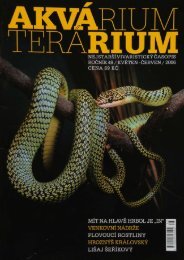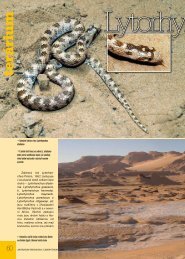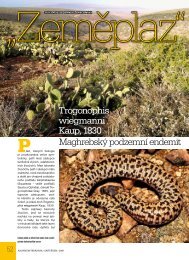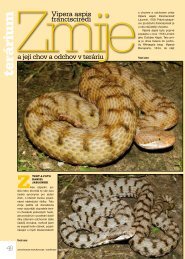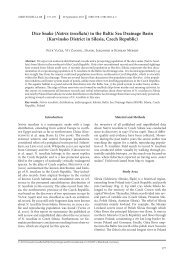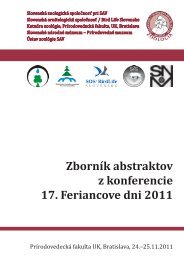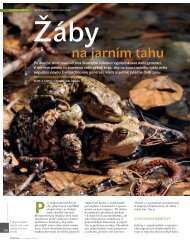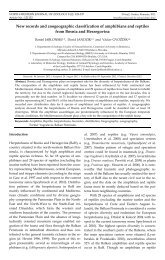Slow worm, Anguis fragilis (Reptilia: Anguidae ... - Daniel Jablonski
Slow worm, Anguis fragilis (Reptilia: Anguidae ... - Daniel Jablonski
Slow worm, Anguis fragilis (Reptilia: Anguidae ... - Daniel Jablonski
Create successful ePaper yourself
Turn your PDF publications into a flip-book with our unique Google optimized e-Paper software.
V. Gvoždík et al. / Molecular Phylogenetics and Evolution 55 (2010) 460–472 467<br />
Table 3<br />
Genetic distances in percentage between the taxa (populations) based on uncorrected p-distances below and above diagonals. Average intraspecific (-population) variation at<br />
diagonals. In mtDNA, distances based on the whole mtDNA fragment below and at the diagonal (in bold), on the ND2 gene solely above the diagonal. In nDNA, the PRLR gene<br />
(in bold) below the diagonal and in front of the slash, and the C-mos gene above the diagonal and behind the slash.<br />
Fragment<br />
Uncorrected H. koellikeri P. apodus P. a. apodus P. a. thracius A. cephallonica A. <strong>fragilis</strong> A. graeca A. colchica A. c. incerta A. c. colchica A. c. orientalis<br />
p-distances (%)<br />
(Europe) (Caucasus) (Caspian)<br />
mtDNA H. koellikeri – 17.9 – – 15.8 17.4 16.4 15.4 – – –<br />
P. apodus 16.0 2.9 – – 13.8 14.6 15.0 14.1 – – –<br />
P. a. apodus – – – 3.1 – – – – – – –<br />
P. a. thracius – – 2.9 – – – – – – – –<br />
A. cephallonica 14.1 12.1 – – 0.5 9.0 9.2 8.6 – – –<br />
A. <strong>fragilis</strong> 15.6 13.2 – – 7.8 0.5 9.2 8.1 – – –<br />
A. graeca 15.0 13.1 – – 7.6 8.1 1.3 7.0 – 6.9 –<br />
A. colchica 14.0 12.4 – – 7.0 7.1 5.8 2.4 – – –<br />
A.c. incerta – – – – – – – – 0.2 4.0 3.8<br />
(Europe)<br />
A.c. colchica – – – – – – 5.9 – 3.5 1.2 4.4<br />
(Caucasus)<br />
A. c. orientalis<br />
(Caspian)<br />
– – – – – – – – 3.2 3.6 1.6<br />
PRLR/C-mos H. koellikeri – – – – – – – – – – –<br />
P. apodus – – – – – – – – – – –<br />
P. a. apodus – – – – – – – – – – –<br />
P. a. thracius – – – – – – – – – – –<br />
A. cephallonica – 1.5 – – – 1.4 1.5 1.4 – – –<br />
A. <strong>fragilis</strong> – 2.0 – – 1.5 0.3/– 0.4 – – – –<br />
A. graeca – 1.8 – – 0.9 1.3 0.5/0.2 0.4 – – –<br />
A. colchica – 1.9 – – 1.4 0.7 1.2 0.3/0.2 – – –<br />
A. c. incerta – – – – – – – – – – –<br />
(Europe)<br />
A. c. colchica – – – – – – – – 0.5 0.2/– –<br />
(Caucasus)<br />
A. c. orientalis<br />
(Caspian)<br />
– – – – – – – – 0.3 0.4 0.2/–<br />
(mt clade B, locality No. 45). Six of the seven mutational steps<br />
were, however, synonymous. Samples from the mt clade C were<br />
distinguished from the most common haplotype Cfc1 by one (or<br />
two) unique mutation step(s).<br />
The PRLR data set contained higher variation than the C-mos,<br />
although still not very high (compare genetic distances in Table 3).<br />
Seven slow-<strong>worm</strong> individuals were heterozygous, three of which<br />
in more than one site (2, 3, 4 sites). One of the three individuals<br />
(sample from the locality No. 9, Greece) was phased with high<br />
probabilities above 0.95, the second one with low probability in<br />
one from three heterozygous positions (probability 0.51; locality<br />
No. 3, Czech Rep.), and the third one with low probabilities in three<br />
from four heterozygous sites (probabilities around 0.70; locality<br />
No. 12, Slovenia). The latter was not further used in the analyses,<br />
while the second one was employed and both haplotype possibilities<br />
as inferred from the ambiguous site were checked. Parsimony<br />
haplotype network was applied for 13 distinct haplotypes within<br />
<strong>Anguis</strong> (Fig. 5B). The Czech sample with one ambiguous position<br />
did not change the network substantially when the other haplotype<br />
combination was applied (not shown). One haplotype stayed<br />
common with one homozygous sample (Pf3, instead of previous<br />
Pf2), while the other one stayed unique on the tip of the network.<br />
Among 544 base pairs in total within the PRLR fragment, 23 base<br />
pair positions were variable, ten of which were parsimony informative,<br />
including the outgroup genus Pseudopus (18 variable, 9<br />
parsimony informative in <strong>Anguis</strong>). The HKY substitution model<br />
(Hasegawa et al., 1985) was used in ML analysis and different codon<br />
position-partitioned models (as in Table 2) in BI analyses.<br />
ML analysis identified the most likely tree with lnL = 927.53<br />
(Fig. 5A). All independent BI runs yielded essentially identical<br />
topologies and likelihood estimates (mean lnL = 932.73). MP<br />
analysis produced four most-parsimonious trees with a length of<br />
25 steps (CI = 0.960; RI = 0.955). Majority-rule consensus tree resulted<br />
in the same topology as ML and BI phylograms. NJ trees<br />
computed based on uncorrected p-distances and the HKY distances<br />
showed also the same topologies and were similar in the bootstrap<br />
support values. The PRLR-translated amino acid sequence data set<br />
consisted of 181 characters, 18 of which were variable, and eight of<br />
these variable characters were parsimony informative. MP produced<br />
four most-parsimonious trees with a length of 21 steps<br />
(CI = 0.952; RI = 0.938). MP majority-rule consensus tree and NJ<br />
tree (both not shown) were very similar to those of the nucleotide<br />
sequence data set (Fig. 5A). The most important difference was that<br />
nucleotide haplotypes Pf1 and Pf2, differing only in one synonymous<br />
mutation, formed a single haplotype in the amino acid data<br />
set.<br />
Combined nuclear data set (PRLR, C-mos) was analysed by ML<br />
and BI, which yielded very similar trees as when based on the PRLR<br />
fragment solely. The main difference was that all samples of the mt<br />
clade C formed a clade with high statistical support (Fig. 6).<br />
A. cephallonica had the most distant haplotype within <strong>Anguis</strong> haplotypes<br />
in the nDNA analyses. Samples from the mt clade C from the<br />
southern Balkans were shown consistently distinctive in both nuclear<br />
genes from the other nuclear haplotypes of A. <strong>fragilis</strong> s.l. However,<br />
variation of the C-mos segment was very low within <strong>Anguis</strong> and not<br />
practical for a phylogeographic approach. The PRLR phylogram<br />
showed samples from the mt clade A (Western Europe, haplotypes<br />
Pf1–Pf4) monophyletic. Samples from the mt clades B2 and B3 (Caucasus<br />
– Caspian region, haplotypes Pc2–Pc5) also formed a monophyletic<br />
group. Samples from the mt clade B1 (Eastern Europe,<br />
haplotype Pc1) appeared as basal in respect to the two monophyletic<br />
groups. Statistical supports of all clades were rather low, although it<br />
was clearly caused by general low number of variable sites.<br />
3.3. Estimation of divergence times<br />
Rate of molecular evolution for the mitochondrial region we<br />
used was estimated to 0.6–0.7% change per lineage per million



